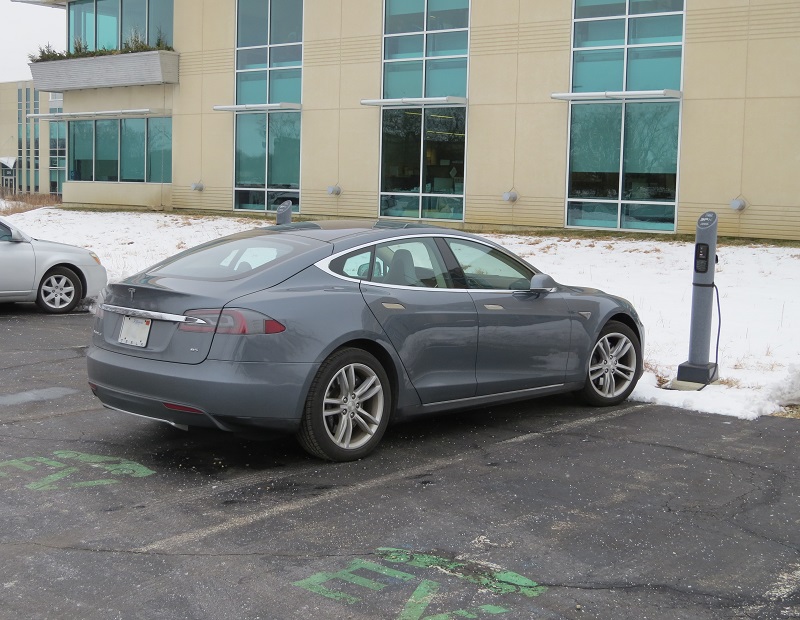Getting Ready for the EV Station Surge
More electric vehicles on the road means rising demand for charging facilities at commercial and multifamily properties. Is the investment worth the payoff?

EV charging station at Wight Co. office (Photo courtesy of Wight Co.)
Along with a steadily larger number of electric vehicles (EVs) on the nation’s byways has come a surge in both number and speed of charging stations. That trend has significant implications for property owners and managers as demand from customers and employees alike is expected to see a similar surge.
In 2018, 361,064 electric vehicles were sold in the U.S., noted Preston Roper, general manager for North America at Boston-based Enel X e-Mobility, which focuses on distributed energy, microgrids, energy efficiency and e-mobility. More than 100 battery-powered electric car models are expected to be available by next year, he added.
Citing Bloomberg New Energy Finance forecasts, Enel X reported that by 2022, EVs and internal combustion models are expected to be comparable in cost. And the Department of Energy estimates that charge points number more than 250,000 nationwide. For its part, Enel X has more than 40,000 charging stations globally and plans to spend $248 million by 2021, with a goal of installing 455,000 EV chargers.
Charging stations fall into three basic categories. Level 3 charging, also known as DC Fast Charging (DCFC), is used for public charging or fleet use and provides an 80 percent charge in less than 30 minutes. Level 3 stations are the most expensive to operate of the three categories—$15,000 to $40,000 per unit annually.
Level 2 charging uses a 240-volt AC plug in homes and workplaces, adding about 25 miles of range per hour charged, according to Chargepoint.com. Annual operating costs typically run from $800 to $6,500 per unit.
Level 1 charging, the most basic alternative, uses a standard household 120-volt AC plug, and provides vehicles very limited additional range, even after the vehicle is charged overnight.
Offsetting those costs are a variety of potential benefits for operators, tenants and customers alike: reduced vacancy rates, increased foot traffic and identifying the the property as a local EV charging “node.” At best, the EV stations help future-proof the property as EV charging becomes a necessity.
Game Changers
Lois Vitt Sale is one of several EV owners at Wight & Co., a Darien, Ill.-based design and construction firm. Her all-electric, 238-mile range Chevy Bolt gives her both a professional and personal interest in charging.
“The landscape is changing from my perspective in the need for charging stations,” said Sale, the firm’s chief sustainability officer. “For a long time, the only long-range vehicles were Teslas. Because the ranges have been extended [on other makes], there is not as much need for charging. I can now go all over the Chicago area in the Bolt without charging.”
Level 3 charging “is a game changer,” Sale said. “I’ve yet to have a client say to me, ‘Put in a Level 3 charging station for me.’ There is a first cost to it, but in the order of magnitude it’s not insanely costly.” Not installing Level 3 chargers could be a missed opportunity, Sale added.
Fast charging could give owners and operators of retail buildings a leg up in garnering additional business, she contends. “If you get drivers to stop for half an hour, you have an opportunity to sell them a cup of coffee or to get them to buy something,” she said. “Pairing Level 3 chargers with interesting experiences for 30 minutes, that’s a cool thing. Get going and build some Level 3 chargers.”
All of these considerations help explain why fast-charging EV stations are an increasingly common subject of investment. In Chicago, for instance, the parking garage at the mixed-use development NEWCITY features 10 “super charging stations” recently installed with the collaboration of Tesla, reported Hide Kashima, senior program director at Structured Development.
Fast Charging and the Future
How fast could fast charging ultimately get? “What you want to get to is the same fill-up speed, five minutes, as gasoline,” said Stephen Voller, CEO and founder of ZapGo, an Oxford, England-based company working to develop a new generation of batteries beyond lithium. Increase the chargers to 1 megawatt, meaning 1,000 kilowatts, and a vehicle can be filled up in five minutes, he said. That’s the good news.
The hitch is the surge in demand for power. An average house uses 30 kilowatts of electricity a day. “This would be 30 times that,” Voller said. “If everyone on an apartment block switches to these fast-charging chargers, and they leave for work and come home at approximately the same time, it’s a massive problem for the grid.”
ZapGo has developed technology centered on storage batteries that can be installed beneath commercial buildings and recharged at night, when the cost of electricity declines. EV owners could then charge their vehicles from these underground batteries, rather than from the grid. “The special property of these batteries is they don’t catch fire, and obviously you can’t use lithium ion batteries in these settings, because they can catch fire,” Voller said.
He believes the electric vehicle segment’s transformation can be compared to that of mobile phone technology. Twenty years ago, mobile phones “were brick phones,” Voller said. “Tesla is the equivalent to a brick phone today. What we’re going to see this year and next are major announcements from the major vehicle brands . . . that will allow them to hold on to their traditional customer base and not see it go to Tesla. The stage after that is when we move to the vehicle equivalent of today’s smart phones.”







You must be logged in to post a comment.